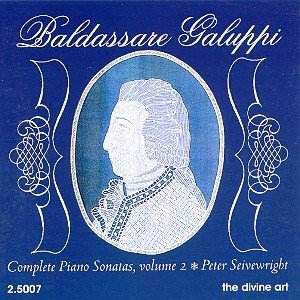Baldassare Galuppi was a Venetian who enjoyed a long career
as a composer of chamber and keyboard music as well as a great deal of
music for the church and stage. A reactionary to the pervading Enlightenment
philosophies of his day, Galuppi was heavily influenced by the writings
of those who stood in opposition to the likes of Voltaire and Diderot.
Rather he espoused the less utilitarian and more romantic views of men
like Giambattista Vico (1668-1774), Johann Georg Hamman (1730-1788) and
Johann Gottfried von Herder (1744-1803).
Peter Seivewright is as much the scholar as he is the
performer, providing us with a provocative essay on the so-called Counter-Enlightenment,
and the effects that the wars and political machinations of Galuppiís
time had on the composer, indeed, had on music history itself. The essay
is well written, and I have to stop to give it special praise in light
of the ever-diminishing quality of program notes for classical recordings.
The music is elegant, with hints of the past and predictions
of the future. As Hans Keller put it, "Great composers link the
past with the present. The greatest composers link the past with the
future." I believe that Galuppi succeeds in being an original,
if not always interesting voice, leaving us with a framework, the architecture
of which was patterned after Scarlattiís blueprint, and upon which greater
lights such as Mendelssohn, Schubert and Schumann would later build.
The music here is charming, but not necessarily memorable.
I didnít find myself whistling any tunes after the pieces were finished.
I did, however, find myself stopping to listen again to some elegant
turns of phrase and some harmonic progressions that were certainly advanced
for their time.
Mr. Seivewright obviously admires this music. His scholarship
into the composerís life and times bears witness to a passion for his
work, and a scholarly ethic that commands respect. Alas, I wish that
I could be as enthusiastic about his piano playing.
Letís start first with the instrument itself. Although
it is billed as a Steinway "D" model piano, it sounds to my
ears as though it is in serious need of refurbishing. The upper registers
are clangy and brittle, and overall we never get a truly warm sound.
Further, the recording is close, and the sound immediately makes me
think that I am listening to a giant piano in a closet. The sound quality
becomes a major distraction early on.
Further, I found that I was listening to a very opinionated
performance. It is evident that Seivewright has his own ideas about
what this music is supposed to sound like. The halting playing, lack
of line tension and the image that I was listening to a pianist playing
over, rather than through a composer continually disturbed me. (Glenn
Gould would have been proud.)
Mr. Seivewright must however be applauded for bringing
this composer to light. This is indeed worthy music, and as ever, one
can hope that these sonatas might occasionally show up on a recital
program. It would be a shame if these elegant sonatas were consigned
forever into the specialistís repertoire. And it is too bad that we
have only this interpretation to go on. Valiant as the effort is, and
informed and enthusiastic as this performer seems to be, there it too
much in the performance to make the listener uncomfortable for me to
give this disc an unqualified recommendation.
Should you buy it? If you are a fan of unusual keyboard
music, then yes indeed. But it might be more fun to go out and buy the
scores and see what you can come up with on your own. I think that the
latter experience would be more rewarding than repeated listenings to
this recording.
Kevin Sutton
See review of
Volume 1
A comment from The Divine Art
the reviewer refers to getting the scores; only 2 sonatas
on this disc were published (ages ago in doubtful versions) and these
performances are based upon our own reconstruction of the manuscripts
- the aim being to publish the entire oeuvre when all 10 Cds are recorded.
On a point of opinion, so far as the sound is concerned, we did deliberately
record the piano very closely, we wanted to get the full benefit of
the modern grand's facilities but at the same time try to capture a
more restricted overall sound more in tune with the 18th century instrument.


